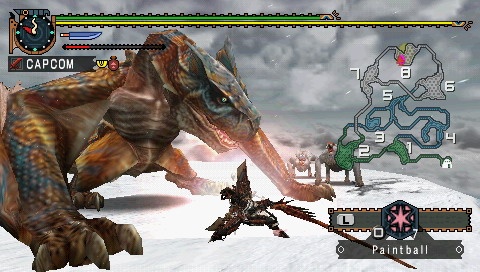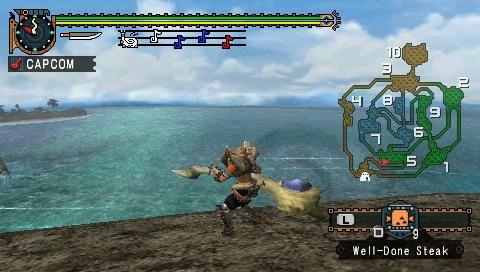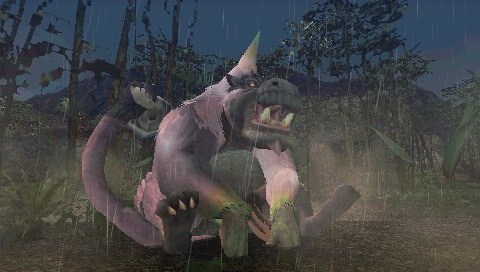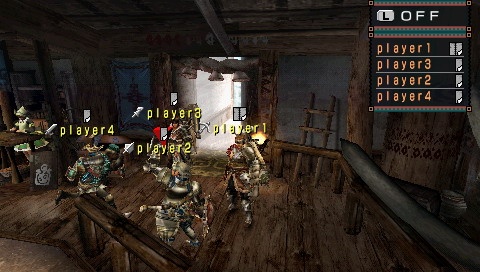It may not sound like it, but Monster Hunter Freedom 2 is perfectly named. Like its title, the game is a hodgepodge of elements crammed together without a trace of grace, elegance, or even coherence. Half the game is hunting monsters. The other half is haplessly fiddling with a bazillion random craft items, ordering cats to cook barbeque, and dressing a pig. You'll never be at a loss for things to do, though you may be at a loss in general.
That is, unless you've played Monster Hunter Freedom or Monster Hunter G, which are basically the same game as Freedom 2. Like the previous PSP entry, the latest lacks a lock-on system, is afflicted with a terrible camera, and misses the Internet play that made Monster Hunter G so amenable. It also struggles under the weight of its content; the quests, rewards, weapons, and crafts are all out of sync, so you'll find yourself with a million items you don't need, and be forced to grind earlier quests for the few things that you do. It isn't all bad--the cooperative play returns, the environments look incredible, and there is a ton of content. But the overall game is unbelievably obtuse and frustrating.

At times, it gets so irritating it'll make you want to throw it off a cliff, which, fittingly, is how the game begins. Your character is in a snowy mountain pass, when a big dragon lunges down and triumphantly knocks him or her into oblivion. What a great start! You're rescued by suspiciously kind villagers, who nurse you back to health, train you, offer lots of advice, and even give you your own house. But there's nothing creepy going on, it's just a shabbily constructed excuse to get you hunting monsters, especially in light of the fact that falling is the one thing in the game that can never, ever hurt you.
Before you get kicked off the cliff, you make a lightly customized character (you decide on sex, hair color, and battle shouts). After the cliff, you wake up in your house. This contains a chest for item storage, a closet where you can change your hair, a bookshelf, and eventually a piglet you can dress. After checking out your new digs, you'll head into the village to meet people, who will politely direct you to the hunter training academy without so much as a word about your embarrassing defeat.
Hunter training, it turns out, is like a small version of the entire game. You run quests to learn the basics, as well as one for each weapon, and a few more on top of that. But in spite of the long list of training missions, it's easy to feel overwhelmed. The game throws 11 completely different weapons at you, as well as about a dozen different items, plus a phone book's worth of information on how to use it all.
Once you finish training, you return to the village with some cash, and the normal game begins. The basis is this: You select a quest, complete it in one of six fields, then come back and tend to your garden, talk to your cat chef, see about new weapons, and then start over. Selecting a quest is simple: There is a huge list broken into difficulty ratings. Once you've completed all the quests at a certain level you'll gain access to an urgent quest which, upon completing, will make the next level available to you.

Quests come in three types: gathering, hunting, and slaying. In gathering quests, you're after things like herbs, mushrooms, or hides that can be collected from the flora and fauna of a given environment. In hunting quests, you're after one particular beastie--typically the biggest, nastiest one in the area. Slaying quests, on the other hand, ask you to kill a large number of relatively weaker enemies. For the most part, slaying and gathering quests are no-brainers, but the hunting quests are a fanged horse of a different color.
The objectives of these quests are also the stars of the series, including huge, frilled dinosaurs that fly and spit fire, big-assed baboon scorpion monsters, and the tyrannosaurus tiger bat creature that knocks you off the cliff in the beginning. All are impressive chimeras with tons of hit points and devastating attacks, but most have one weakness in common--getting stabbed in the posterior. By constantly circling your foes and hacking away at their behinds, you can avoid their devastating attacks while causing plenty of damage.
This leads to some truly horrifying battles, as it can literally take you a half an hour of butt-stabbing a monster to finally kill it. You should know, though, that this stratagem doesn't universally apply to all weapons in the game. If you wield the gunbow, for instance, you'll mostly run around taking potshots for an hour until the beast is felled by the 6,000th bullet. Or if you go with the giant hammer, you'll deal stunning blows to the head, and then hammer away.
While smacking your enemies in the noggin might sound more heroic than stabbing them in the butt, every approach has serious drawbacks that go beyond the boundaries of normal game balance. Indeed, combat tends to be awful in Freedom 2 no matter what weapon you wield. For one thing, you can't lock onto your enemies. For another, the camera is controlled with the D pad, so you can't move and adjust the camera at the same time. That's why running circles around an enemy while hacking at their shanks is one of the best options--it requires the least amount of camera adjustment. Watch out, though: If you enter a command during the wrong bit of animation, it won't execute. It isn't rare, for instance, to run up to an animal's tail end, hit the button to swing, and see your character just stand there.

However you elect to attack your quarry, it'll eventually run away to lick its wounds, but you can counter this by pelting it with a paintball, which then shows the monster's location on your minimap. You'll need more in your inventory than just paint, though. You'll need health potions to regain lost hit points, food to replenish stamina, whetstones to sharpen your blades, hot or cold drinks to protect you from various environmental conditions (if it's supercold, your stamina will quickly diminish without a hot toddy), traps to lay for the monsters, and stuff to throw at them while they're trapped. Some of this is provided for you at the start of a given quest, but at other times you'll realize, after 20 minutes of very dirty fighting, that your blade has dulled and you forgot to bring whetstones. Ouch.
While a dull blade might seem more painful in some ways than a sharp one, you'll have to head back to town for more whetstones if you ever want to kill anything. In town, you can either buy what you need (which is usually superexpensive), or craft it. But things aren't quite that simple. There are roughly a million crafting reagents in Freedom 2 that, when combined, will create another item. However, instead of recipes, all you have is a 160-entry list of combinations that details which items can be combined, but not what they make--that is, until you make one of them. So rather than knowing you want to make an item and gathering the ingredients, you have to blindly combine things until you stumble upon the item you were originally looking for.
This is complicated in two ways. The most useful items are created by combining previously crafted items, so you have to literally find your way through a multilevel blind maze of unintuitive combinations before making anything useful. Furthermore, you store your items in a big box with room for 100 different things (though later it can be made to hold more), yet you can carry only 30 items in your inventory. Only items in your inventory can be combined, yet you need to try combining everything. So to work your way through the system, you have to constantly swap items in and out of your inventory, while inevitably losing track of it all. This may be the most obtuse crafting system ever.
Still, some ingredients, such as honey (which turns normal potions into awesome potions) are obviously more valuable than others, so you'll want to head into the field to gather the good stuff. You can also go to your own personal farm, which is conveniently run by cat people. On the farm, you can catch three fish, capture three bugs, mine three ore, harvest up to three rows of crops, plant trees, tend bees, and all sorts of other things every time you finish a quest. You can also buy one of the little cat people (called Felynes) a boat, and fund his expeditions to various zones, after which he'll return to you with presents. This farm is the best part of the game, and will drive you to go out and complete quests so you can come back and see what's developed.
Another nice feature is the ability to meet up to three other friends for ad hoc monster hunting. The problems with the combat still apply, but taking down big monsters with a band of buddies is a totally different experience, camera issues be damned. That's why it's so disappointing that yet again, the game lacks Internet play. This series is much better when you play with a party, but if your friends aren't around, you're stuck going stag. My kingdom for some bots.

Speaking of the kingdom, or at least the world, the environmental graphics really got the royal treatment. The mountain lake is a serene pool that reflects the sky, while further up into the snowy heights, white wind swirls about your hunter, threatening a blizzard. Then there's the tropical jungle, surrounded by azure water and adorned with vivid rainbows. Sadly, these good looks come at a high price--Freedom 2's loading times are frequent and lengthy. You'll face a long loading time when you begin a quest, load every time you move from zone to zone within an area, and reload when you win or lose. With graphics, as with everything else, this game bites off more than it can chew.
It's easy to admire Monster Hunter Freedom 2's ambition--it has many of the ingredients of a good online RPG. But to handle all those disparate elements, you need a recipe for success, and that's something the game lacks. There's no coherent system or vision underneath all the quests, items, and monsters, and as a result the overall product is much less than the sum of its parts. While it certainly offers plenty of meat for those who decide to bag it, there is certainly better game elsewhere.